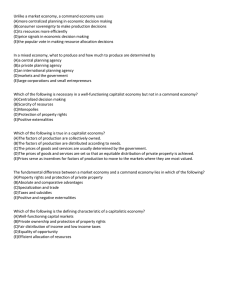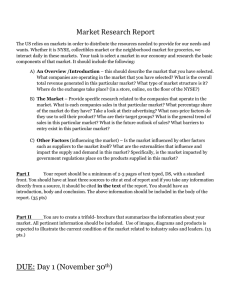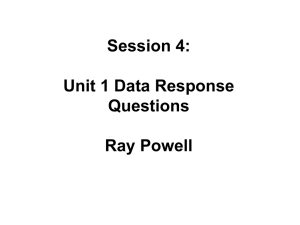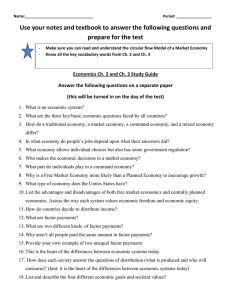Market Failure & Government Intervention Analysis
advertisement
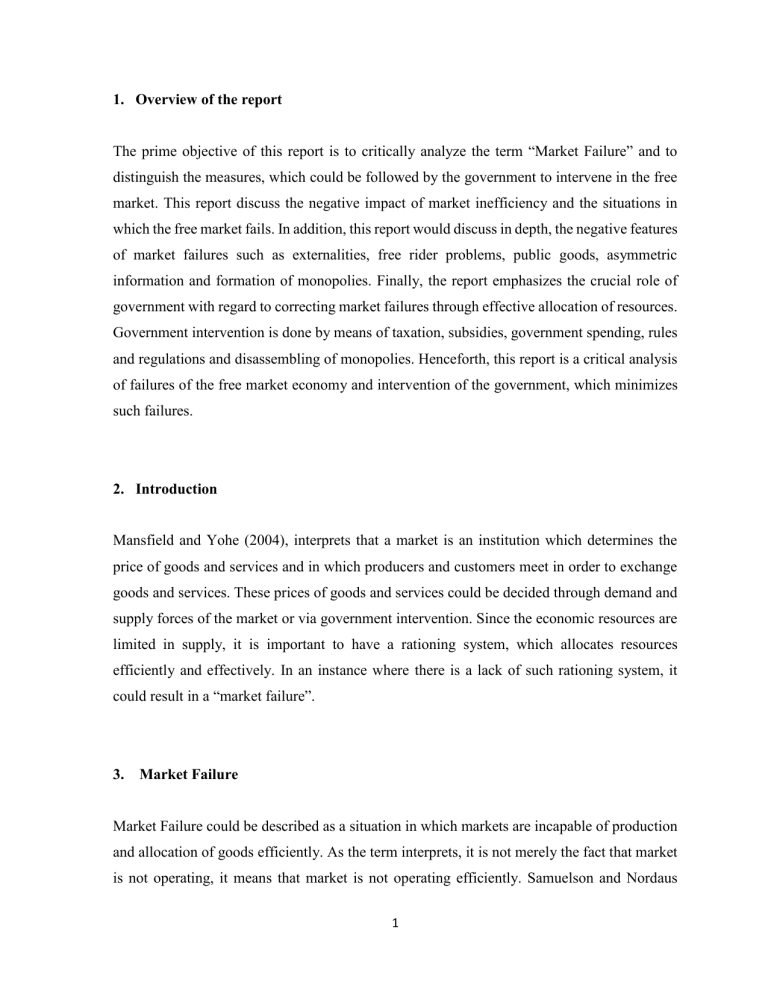
1. Overview of the report The prime objective of this report is to critically analyze the term “Market Failure” and to distinguish the measures, which could be followed by the government to intervene in the free market. This report discuss the negative impact of market inefficiency and the situations in which the free market fails. In addition, this report would discuss in depth, the negative features of market failures such as externalities, free rider problems, public goods, asymmetric information and formation of monopolies. Finally, the report emphasizes the crucial role of government with regard to correcting market failures through effective allocation of resources. Government intervention is done by means of taxation, subsidies, government spending, rules and regulations and disassembling of monopolies. Henceforth, this report is a critical analysis of failures of the free market economy and intervention of the government, which minimizes such failures. 2. Introduction Mansfield and Yohe (2004), interprets that a market is an institution which determines the price of goods and services and in which producers and customers meet in order to exchange goods and services. These prices of goods and services could be decided through demand and supply forces of the market or via government intervention. Since the economic resources are limited in supply, it is important to have a rationing system, which allocates resources efficiently and effectively. In an instance where there is a lack of such rationing system, it could result in a “market failure”. 3. Market Failure Market Failure could be described as a situation in which markets are incapable of production and allocation of goods efficiently. As the term interprets, it is not merely the fact that market is not operating, it means that market is not operating efficiently. Samuelson and Nordaus 1 (1992:741), defines Market Failure as a shortcoming of the price mechanism, which restrains the efficient allocation of resources. Accordingly, price mechanism interprets the adverse effects such as the absolute cost and value of products, with imperfect competition, asymmetric information, natural monopoly and externalities. Significantly, for a market to be classified as an imperfect market following assumptions are emphasized by Mansfield and Yohe (2004), 1. Majority of the individual producers are incapable to influence the current market price 2. Lack of control over the current market price by majority of the individual customers 3. Free entry-exit barriers, in which firms enjoy normal profits during the long run 4. Homogeneous products, in which firms play the role of price takers with a perfectly elastic demand curve for its product 5. Accessibility for perfect information at zero cost. 6. Perfect mobility of factors of production which can be exchanged with regard to varied market conditions In contrast, as emphasized by Stieglitz and Brown (2000), where these assumptions are not held, the market is imperfect and is unable to allocate resources efficiently, which emphasizes the importance of government intervention. According to Le Grand, Propper et al. (2008), free market is unable to operate efficiently in order to achieve the objectives of the society, such as social welfare. Therefore, government must play a crucial role in order to maximize social welfare. As Le Grand Propper et al. (2008), states an efficient market system should maximize the net benefit for the society. This does not merely imply that the market system should be fair with regard to the benefit received by the individuals. Government should intervene when there is inequality in distribution of the gross income of the country. Even though a market achieves maximum efficiency, benefits of market activities are not fairly distributed. Adam Smith as well mentioned that a society should not ignore the fact that equity 2 is to be maintained while achieving efficiency. His exact words were that “no society can surely be flourishing and happy, of which the greater part of the members are poor and miserable (Smith, 1776). Therefore, in a scenario where the market economy ignores maintain equity, the government must intervene for the benefit of the society. 3.1. Causes of Market Failure 3.1.1. Externalities In the free market, there are instances where the value that an individual pays for a good and service is often higher or lower than the opportunity cost that society as a whole pay for the same good and service. In other words, in a competitive market place, it is possible that there will be spill over benefits or costs to third parties who are not involved in a particular transaction that happens between a firm and a customer. These spillover benefits and costs to third parties are commonly known as externalities. Externalities are further broken down two parts called, negative externalities and positive externalities. Negative externality is where the cost borne by the society as a whole is more than the private cost of the economic transaction borne by the firm and the customer. Some of the examples for negative externalities would be consumption demerit goods that creates spillover cost to third party such as, smoking in public, which creates passive smoking for nonsmokers or pollution of air, and open public space due to a construction of a new apartment building. Negative externalities are classified as market failure since in the free market; actions and steps are not taken to reduce the gap between the private cost and social cost. Negative externalities of smoking and its market failure can be graphically illustrated from the figure 3.1.1. 3 Figure 3.1.1: Negative Externalities of Smoking Source: Author It is also important to understand and acknowledge that not all externalities are negative. There can be spillover benefits for the third parties from production of a good or service, which explained in detail under the following topic. 3.1.2. Free-rider Problems Positive externalities arise when social benefit exceed the private benefit from the production and the consumption of a good or service. In effect, some benefits related to these goods and services are provided free. Some of the examples for positive externalities can be listed as medical research, tree farming which serves as an environment function to capture CO 2 from the atmosphere, flood control, street lighting, roads, bridges etc. Positive externalities are also considered as market failure since in the free market these goods and services becomes unprofitable to produce due to it been jointly consumed by the consumers and the non-paying beneficiaries cannot easily be excluded from the benefits of the good and service. Hence, positive externalities are also called as problem of the free-rider. 4 3.1.3. Public goods Public goods are goods or services, which have both non-rivalry and non-excludable characteristics. Non-rivalry can be explained when the benefits provided by a public good can be enjoyed by any individual without infringing the benefits for another individual. Nonexcludability is where the benefit of a good or service can be enjoyed by any individual of the society with or without making any payment for the good or service. Since individuals cannot easily be charged for the benefits of public goods, which can also be enjoyed by all parties free of charge, private firms will not allocate any resource to produce and supply public goods. Therefore, government or the public sector enterprises typically must provide these goods. Some of the examples of public goods are national defense, city parks, street lights, light houses, medical researches, police protection and free ambulance services. 3.1.4. Asymmetric Information Theory of markets is based on the assumption of availability of all information uniformly throughout the market. However, in reality this is not the case and consumers are not in possession of full information all the required information to make the best decision about how much of a product to consume. This leads to two types of socially unfavourable situations: over consumption of demerit goods and under consumption of merit goods. A classic example for over consumption of demerit goods is soft drinks which contain a high content of sugar. Many people in Sri Lanka have been used to consume such drinks instead of water just to quench their thirst without knowing the actual sugar content. Few more similar examples for over consumption of demerit goods are cigarettes, liquor, food with chemical additives. Reconditioned vehicle market is another example where countries like Japan have imposed laws to issue each vehicle with an auction grade by a government approved authority such as JAAI. This is to ensure that the buyer is aware of the actual quality of the vehicle. 5 3.1.5. Formation of Monopolies In certain industries like electricity distribution, water supply, telephones, railway, etc. the initial capital investment required for a firm to enter the industry is so high. Economies of scale are essential for firms in such industries to exist and offer its product or service to the consumer at an acceptable price. There exists the advantage of a single producer being able to avoid wasteful duplication of resources due to competition and thereby offering a lower price to the consumers. There are circumstances where governments have to allow firms to run legal monopolies due to patent and copy rights of inventors as well. For any reason, allowing a firm to drive a monopoly can restrict the output and charge a higher price to the customer with its motive of earning a maximum super normal profit. Therefore, even in such industries, formation of a monopoly can lead to inefficient use of economic resources. 4. Government intervention As explained on the previous chapters market failure can be defined as the circumstances where the free market does not allocate the resources efficiently. The inability to satisfy the society’s wants and majority of environmental problems such as polluted soil, air & sea and ozone layer vaporizing can be listed as examples of market failure. This is because of the fact that, in free market economy none of the parties are concerned in maintaining the cleanliness of the environment. Therefore, even in the free market, when the forces of supply and demand do not allocate resources efficiently, there is dire need for the government and its intervention to re-correct the market failures. (Friedman1 1962). There are number of instruments available for the government to intervene with market failure and can be explained under each of the following subheadings. 6 4.1.Government Taxation Taxation is key part of a government’s revenue where majority of the taxes are obtained through taxes on personal incomes and organization profits and minor part is contribute through taxes raised on environmental taxes levied on environment pollution, carbon and waste usage. However, with the government intervention of correcting market failure such as negative externalities of consumption and production, the taxation system should evolve from simple mechanism of just raising money to provide essential public goods and services to changing the patterns of consumer expenditure and behavior. In other words, by influencing the final market price of a good or services through taxations the government affects not only the allocation of resources in the free market but also by raising the prices of the goods and services which has negative externalities government also seek to reduce the quantity demanded of those goods and services. Impact of taxation on quantity demanded can be graphically illustrated from the figure 4.1. Figure 4.1. : Impact of Taxation Source: Author 7 4.2. Tax Relief and Subsidies In the same manner where government can influence the consumers purchasing and behavior pattern through taxation, the government could also intervene in the free market and affects its forces of supply and demand through providing tax reliefs or subsidies to consumers and producers. Tax Relief and Subsidies would lead to increase in the supply of goods and services, which has positive externalities to the society, and eventually lead to increase in the quantity demanded by the consumers. For example reducing the import tax on buses and coaches would increase the supply of public transportation services and would discourage private vehicles entering the cities during peak hours by more travelers opting to go public transportation. 4.3. Government Spending Public goods are a classic example for the need of government intervention in the free market, as these are a few goods and services, which the market mechanism does not supply effectively. As it is difficult to charge individuals for the consumption of public goods due to its inherent nature, and as the benefit of public goods is enjoyed by large number of people, public goods are not transact in the market place. Due to this reason, the government would have to intervene to provide state provisions and spending on public goods and services in the free market. 4.4. Legislation and Regulation Through setting regulations, the main objective of the government is to seek control of the amount purchased or consumed of a good or a service and thereby influence the forces in the free market for efficient resource allocation. The prevention of use of drugs such as heroin and cocaine is a good example of government seeking to discourage consumption demerit goods or services. In addition, regulations are also designed not only to redistribute the income of the society but also to promote environmentally friendly product purchasing where the government is intervening to avoid indolence of the society and organizations with regards to products which have positive impact towards environment. Some of the common regulations implemented by the government to intervene in the free markets are, setting a minimum age 8 for purchase and consumption of cigarettes and alcohol, stating minimum wage for employees, passing equal pay act and other legislations that prevent any kind of discrimination etc. 4.5. Publicity and Information This method of corrective action for market failure is highly important when the free market is in absence of transparency due to issues in asymmetric information. Therefore, in such cases government intervene to gather and share information to support and influence forces of supply and demand. Publicity and information campaigns might take the form of advertising to promote merit goods or even the form of compulsory labelling on demerit goods. For example, Sri Lankan government made it compulsory to label the sugar level of carbonated drinks with a colour code to indicate high, medium and low sugar content of the product. Whereas an example for publicity campaign of the government could be, a campaign implemented to increase awareness on carbon footprint of various products. The ultimate objective of the government of conducting these campaigns is to enable more efficient allocation of resources in the market. This is achieved by creating a greater equilibrium between the expectations of the consumers and the knowledge of suppliers, through improving flows of information in the economy. 4.6. Disassemble Monopolies Governments intervene to natural monopolies in two ways. One is to get the ownership of natural monopolies by the government itself by enforcing public ownership institution regulations. In Sri Lanka, live examples are available in the form of Ceylon Electricity Board, National Water Supply and Drainage Board, Sri Lanka Railways, Airport & Aviation Services (Sri Lanka) Limited, etc. The second tactic of governments is to impose regulations to introduce price capping and ensure minimum standards of goods and services, thereby preventing the abuse of monopoly power by firms. In developed countries such as United Kingdom, there are government driven entities to prevent unfair trading which prevent 9 collusions, limit market share of firms, prevent intentional low pricing to force rival firms out of the market, prevent stocking rivals products, etc. All such actions are aimed at preventing tendencies to formation of a monopoly or abusing market power by firms and thereby preventing market failure. 5. Conclusion Throughout this report, it is discussed in detail how market failure arises, the types of market failure in the free market and how the government can intervene to rectify those market failures. However, it is also important to note that not all market failures can be simply rectified by government intervening with the forces of supply and demand. This is mainly due to government’s political process is inherently inefficient in allocating resources. In the free market resources are allocated through the market mechanism whereas politicians allocate resources in the basis of judgment which is usually influenced by lack of financial incentives, gaps in accurate information and pressures applied from various interest groups that needs to be considered for the re-election. Therefore, an argument can be built to emphasize, that the more wide spread and detailed the government intervention becomes, less likely it will be impactful to rectify some of the market failures. Thus the present trend, will mainly focus on providing government incentives through the market system which means that taxation and regulation will be the key tools used by the government to reallocate resources efficiently in the free market. 10 6. References Arrow, Kenneth J. 1951, 1963. Social Choice and Individual Values. New York: John Wiley Arrow, Kenneth, and Frank Hahn. 1971. General Competitive Analysis. San Francisco: Assemblies.” Reprinted in Iain McLean and Arnold Urken (1995; eds and translators), Classics Barro, Robert. 1973. The Control of Politicians. Public Choice. 14(1): 19-42. Bator, Francis M. 1958. The Simple Analytics of Market Failure. The Quarterly Journal of Economics. Besley, Timothy. 2006. Principled Agents? The Political Economy of Good Government. Black, Duncan. 1958. The Theory of Committees and Elections. New York, Cambridge University Press Blank, R. M. (2002). "Can equity and efficiency complement each other?" Labour Economics9(4): 451-468. Coase, Ronald H. 1988. The Firm, the Market, and the Law. Chicago: University of Chicago Press. Condorcet (M.J.A.N. de Caritat, Marquis de). 1788. “On the Constitution and Functions of Provincial Economy, 58(3): 211-221. Holden-Day. Congleton, Roger. 2004. "Rent-Seeking and Political Institutions." Encyclopedia of Public Choice. Coughlin, Peter, and Melvin Hinich. 1984. “Necessary and Sufficient Conditions for Single Peakedness in Public Economic Models.” Journal of Public Economics, 25: 323-41. Cowen, Tyler, Amihai Glazer, and Henry McMillan. 1994. Rent Seeking Can Promote the Provision of Public Goods. Economics and Politics. 6:131-145. Datta-Chaudhuri, M. (1990). "Market failure and government failure." The Journal of Economic Perspectives4(3): 25- 39. 11 Dolan, P. and J. A. Olsen (2001). "Equity in health: the importance ofdifferent health streams." Journal of Health Economics20: 823-834. Fonseka, A. T. (2013). Economic Theory & Management Practice, Post Graduate Institute of Management. Le Grand, J., et al. (2008). The Economics of Social Problems. New york, Palgrave Macmillan. Mansfield, E. and G. Yohe. (2004). Microeconomics : theory/applications. New York Norton. Ogu, V. I. and J. E. Ogbuozobe (2001). "Housing policy in Nigeria: towards enablement of private housing development." Habitat International25(4): 473-492. Probability of Decisions Rendered by a Plurality of Votes.” Reprinted in Iain McLean and Quarterly Journal of Economics 84 (3): 488–500.York: MacMillan. Simpson, A. W. Brian. 1996. "'Coase v. Pigou' Reexamined." The Journal of Legal Studies, Vol. 25, No.1 (Jan., 1996), pp. 53-97. Skinner, Oxford: Oxford University Press. Adam Smith145. Slutsky, Steven. 1977. “A Voting Model for the Allocation of Public Goods: Existence of an Equilibrium.” Journal of Economic Theory. 14(2): 299-325. Smith, A. (1776). "1976. An Inquiry into the Nature and Causes of the Wealth of Nations." RH Campbell and AS Sobel, Joel. "Information Control in the Principal-Agent Problem," International Economic Review, Vol. 34, No. 2 (May, 1993), pp. 259-269. Stiglitz, J. E. and E. P. Brown (2000). Economics of the public sector. New York, Norton,. Tisdell, C. and K. Hartley (2008). Microeconomic policy : a new perspective Cheltenham Edward Elgar. Winston, C. (2006). Government failure versus market failure: microeconomics policy research and government performance, Brookings Institution Press. 12

